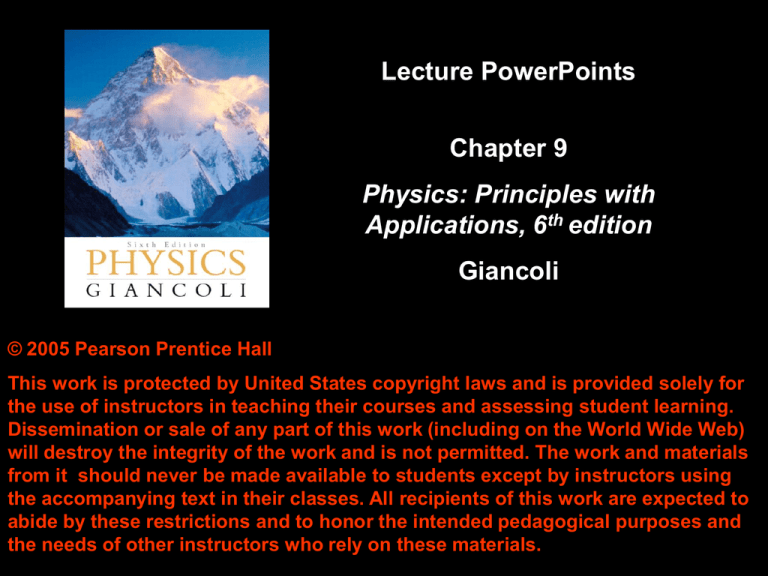
Lecture PowerPoints
Chapter 9
Physics: Principles with
Applications, 6th edition
Giancoli
© 2005 Pearson Prentice Hall
This work is protected by United States copyright laws and is provided solely for
the use of instructors in teaching their courses and assessing student learning.
Dissemination or sale of any part of this work (including on the World Wide Web)
will destroy the integrity of the work and is not permitted. The work and materials
from it should never be made available to students except by instructors using
the accompanying text in their classes. All recipients of this work are expected to
abide by these restrictions and to honor the intended pedagogical purposes and
the needs of other instructors who rely on these materials.
Chapter 9
Static Equilibrium; Elasticity
and Fracture
Units of Chapter 9
•The Conditions for Equilibrium
•Solving Statics Problems
•Applications to Muscles and Joints
•Stability and Balance
•Elasticity; Stress and Strain
•Fracture
•Spanning a Space: Arches and Domes
9-1 The Conditions for Equilibrium
An object with forces acting on it, but that is
not moving, is said to be in equilibrium.
9-1 The Conditions for Equilibrium
The first condition for
equilibrium is that the forces
along each coordinate axis
add to zero.
9-1 The Conditions for Equilibrium
The second condition of equilibrium is that
there be no torque around any axis; the choice
of axis is arbitrary.
9-2 Solving Statics Problems
1. Choose one object at a time, and make a freebody diagram showing all the forces on it and
where they act.
2. Choose a coordinate system and resolve
forces into components.
3. Write equilibrium equations for the forces.
4. Choose any axis perpendicular to the plane of
the forces and write the torque equilibrium
equation. A clever choice here can simplify the
problem enormously.
5. Solve.
9-2 Solving Statics Problems
The previous technique may not fully solve all
statics problems, but it is a good starting point.
9-2 Solving Statics Problems
If a force in your solution comes out negative (as
FA will here), it just means that it’s in the opposite
direction from the one you chose. This is trivial to
fix, so don’t worry about getting all the signs of the
forces right before you start solving.
9-2 Solving Statics Problems
If there is a cable or cord in
the problem, it can support
forces only along its length.
Forces perpendicular to that
would cause it to bend.
9-3 Applications to Muscles and Joints
These same principles can
be used to understand forces
within the body.
9-3 Applications to
Muscles and Joints
The angle at which this man’s
back is bent places an
enormous force on the disks
at the base of his spine, as
the lever arm for FM is so
small.
9-4 Stability and Balance
If the forces on an object are such that they
tend to return it to its equilibrium position, it is
said to be in stable equilibrium.
9-4 Stability and Balance
If, however, the forces tend to move it away from
its equilibrium point, it is said to be in unstable
equilibrium.
9-4 Stability and Balance
An object in stable equilibrium may become
unstable if it is tipped so that its center of gravity is
outside the pivot point. Of course, it will be stable
again once it lands!
9-4 Stability and Balance
People carrying heavy loads automatically
adjust their posture so their center of mass is
over their feet. This can lead to injury if the
contortion is too great.
9-5 Elasticity; Stress and Strain
Hooke’s law: the change in
length is proportional to the
applied force.
(9-3)
9-5 Elasticity; Stress and Strain
This proportionality holds until the force
reaches the proportional limit. Beyond that, the
object will still return to its original shape up to
the elastic limit. Beyond the elastic limit, the
material is permanently deformed, and it breaks
at the breaking point.
9-5 Elasticity; Stress and Strain
The change in length of a stretched object
depends not only on the applied force, but also
on its length and cross-sectional area, and the
material from which it is made.
The material factor is called Young’s modulus,
and it has been measured for many materials.
The Young’s modulus is then the stress divided
by the strain.
9-5 Elasticity; Stress and Strain
In tensile stress, forces
tend to stretch the
object.








